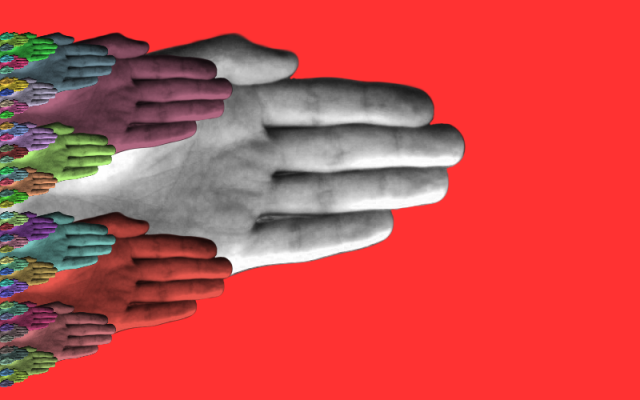int grid = 20;
float b = 0;
ArrayList<Prism> prisms;
//slider variables
boolean dragging = false; // Is the slider being dragged?
boolean rollover = false; // Is the mouse over the slider?
// Rectangle variables for slider
float rx = 50;
float ry = 500;
float rw = 10;
float rh = 100;
// Start and end of slider
float sliderStart = 70;
float sliderEnd = 570;
float offsetX = 0; // Offset for dragging slider
void setup() {
size(640, 640);
prisms = new ArrayList<Prism>();
for (int y = 0; y < width; y += grid) {
for (int x = 0; x < height; x += grid) {
float r = random(1);
color c = color(noise(y, x)*255, noise(y, x)*200, noise(y, x)*55, random(255));
if (r < 0.25) {
prisms.add(new Prism(x, y, x, y+grid, x+grid, y+grid, c /*v*/)); // add a new instance of the class Prism to the arrayList prisms.
}
else if (r >= 0.25 && r < 0.5) {
c = color(noise(r)*105, noise(r)*200, noise(r)*155, random(255));
prisms.add(new Prism(x, y, x+grid, y, x, y+grid, c /*v*/));
}
else if (r >= 0.5 && r < 0.75) {
prisms.add(new Prism(x, y, x+grid, y, x+grid, y+grid, c /*v*/));
}
else {
prisms.add(new Prism(x+grid, y, x+grid, y+grid, x, y+grid, c /*v*/));
}
}
}
}
void draw() {
background(255);
for (int i = 0; i < prisms.size(); i++) {
prisms.get(i).display();
}
b = (int) map(rx, sliderStart, sliderEnd - rw, 2, 6);
noStroke();
fill(color(255, 255, 255, 220));
rect(50, 480, 540, 140);
float d = sliderStart;
while (d < sliderEnd) {
for (float h = -10; h > -100; h = h-2.71) {
fill(color(255, 0, 0, 60));
noStroke();
rect(d, 600, 10, h);
d = d+14.848;
}
}
if (dragging) {
rx = mouseX + offsetX;
}
// Keep rectangle within limits of slider
rx = constrain(rx, sliderStart, sliderEnd - rw);
stroke(0);
if (dragging) {
fill(color(255, 77, 90));
}
else {
fill(color(255, 128, 137));
}
// Draw rectangle for slider
noStroke();
rect(rx, ry, rw, rh);
}
void mousePressed() {
// Did I click on slider?
if (mouseX > rx && mouseX < rx + rw && mouseY > ry && mouseY < ry + rh) {
dragging = true;
// If so, keep track of relative location of click to corner of rectangle
offsetX = rx - mouseX;
}
}
void mouseReleased() {
// Stop dragging
dragging = false;
for (int i = 0; i < prisms.size(); i++) {
if (prisms.get(i).should_grow()) {
prisms.remove(i);
}
}
}
void mouseWheel(MouseEvent event) {
float e = event.getAmount();
rx -= e;
}
class Prism {
int x1, x2, x3, y1, y2, y3, max_height, current_height, desired_height, x_offset, current_x_offset, desired_x_offset, mouseRange;
color c;
Prism(int tempx1, int tempy1, int tempx2, int tempy2, int tempx3, int tempy3, color tempcolor) {
x1 = tempx1;
y1 = tempy1;
x2 = tempx2;
y2 = tempy2;
x3 = tempx3;
y3 = tempy3;
c = tempcolor;
max_height = (int) random(100);
current_height = 1;
current_x_offset = 0;
desired_x_offset = 0;
mouseRange = (int) random(10, 50);
x_offset = (int) random(30, 100);
}
boolean should_grow() {
//needs to be fixed because some prisms aren't getting picked up
if (mouseX > x1 - mouseRange && mouseX < x1 + grid + mouseRange && mouseY > y1 - mouseRange && mouseY < y1 + grid + mouseRange) {
return true;
}
else {
return false;
}
}
void change_height() {
if (current_height < desired_height) {
current_height += b;
}
else if (current_height > desired_height) {
current_height -= 1;
}
if (current_x_offset < desired_x_offset) {
current_x_offset += b;
}
else if (current_x_offset > desired_x_offset) {
current_x_offset -= 1;
}
}
void change_color() {
c = color(random(255), random(255), random(255), random(255));
}
void display() {
fill(c);
if (should_grow()) {
desired_height = max_height + int(b) *20;
desired_x_offset = x_offset;
}
else {
desired_height = 0;
desired_x_offset = 0;
}
noStroke();
triangle(x1, y1, x2, y2, x3, y3);
if (current_height > 0 || current_x_offset > 0) {
stroke(255);
quad(x1, y1, x2, y2, x2 - current_x_offset, y2 - current_height, x1 - current_x_offset, y1 - current_height);
quad(x1, y1, x3, y3, x3 - current_x_offset, y3 - current_height, x1 - current_x_offset, y1 - current_height);
quad(x2, y2, x3, y3, x3 - current_x_offset, y3 - current_height, x2 - current_x_offset, y2 - current_height);
triangle(x1 - current_x_offset, y1 - current_height, x2 - current_x_offset, y2 - current_height, x3 - current_x_offset, y3 - current_height);
}
change_height();
}
}
